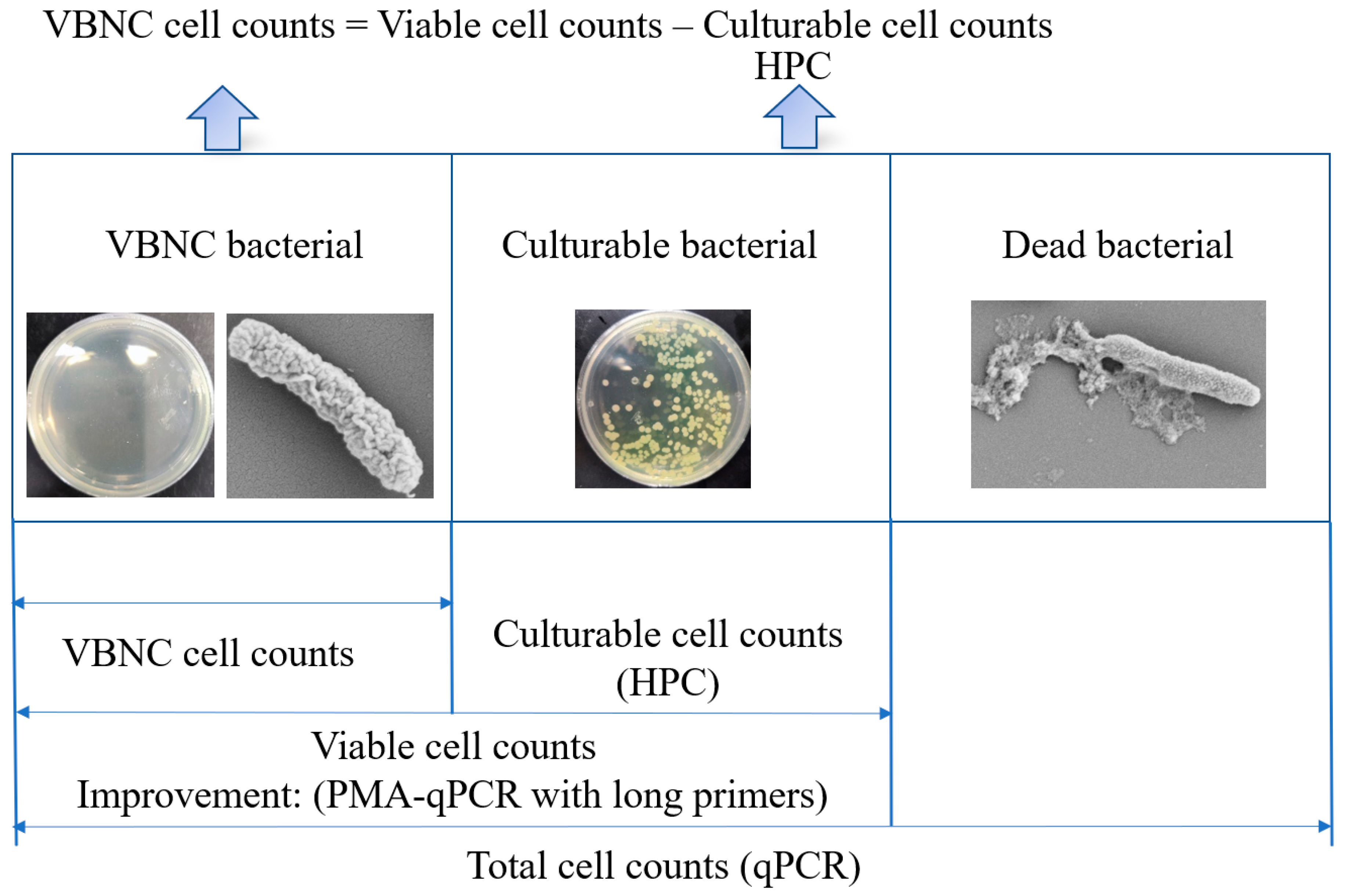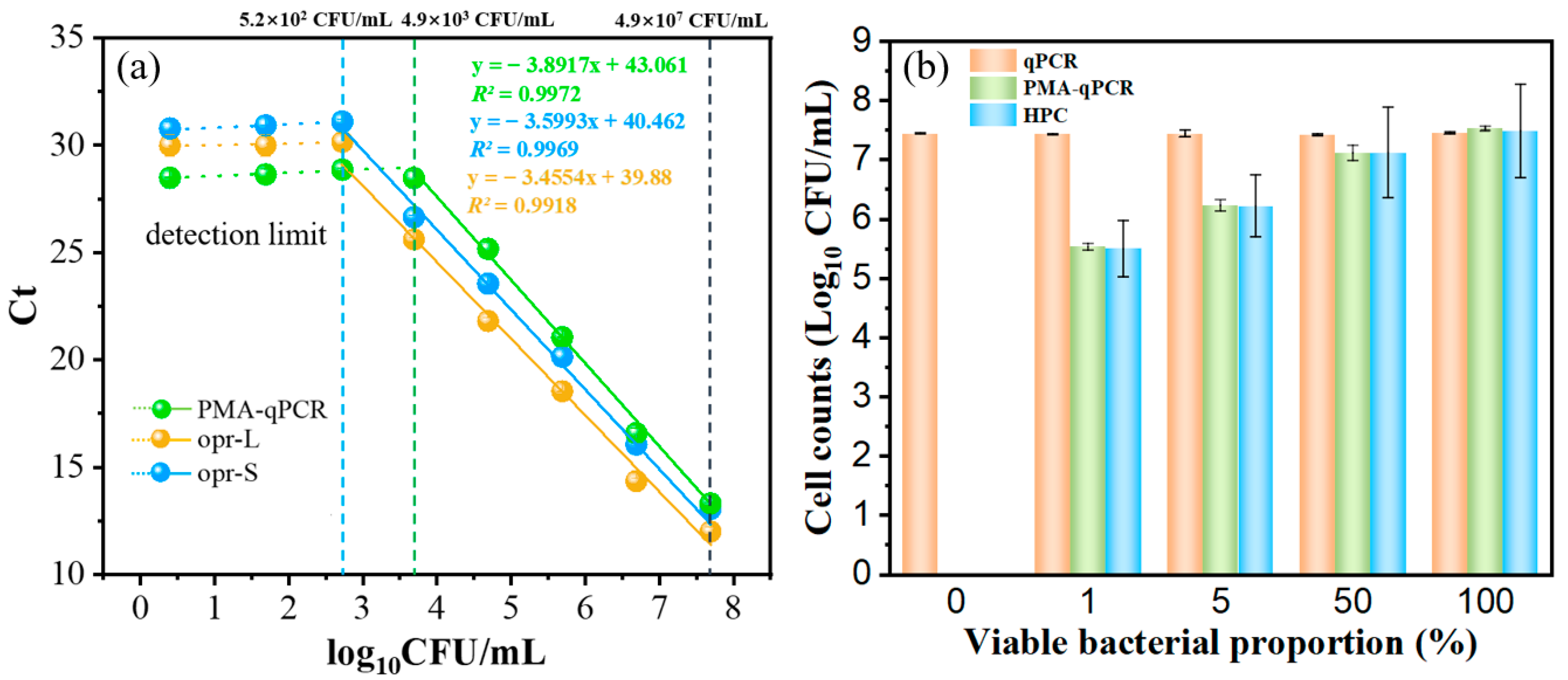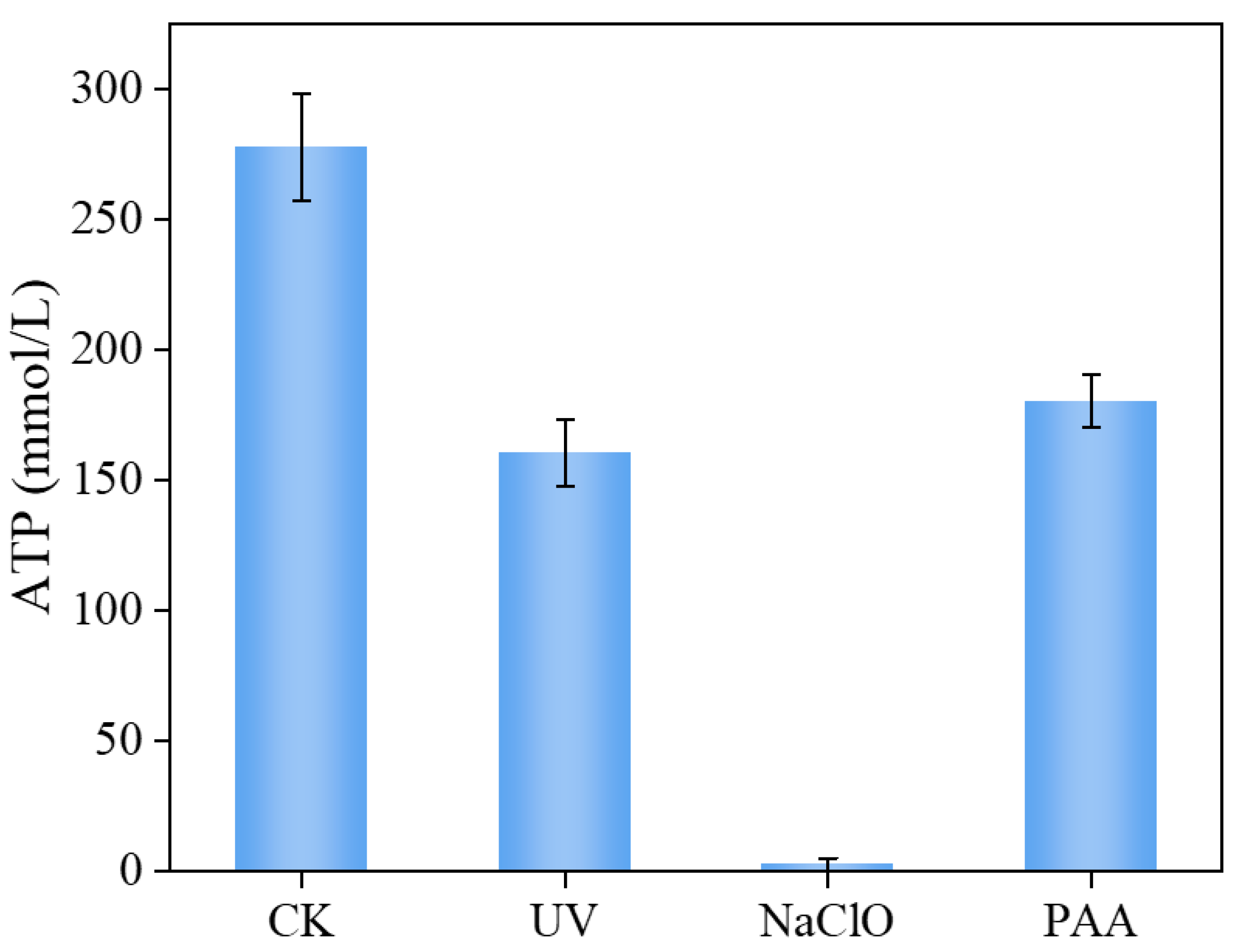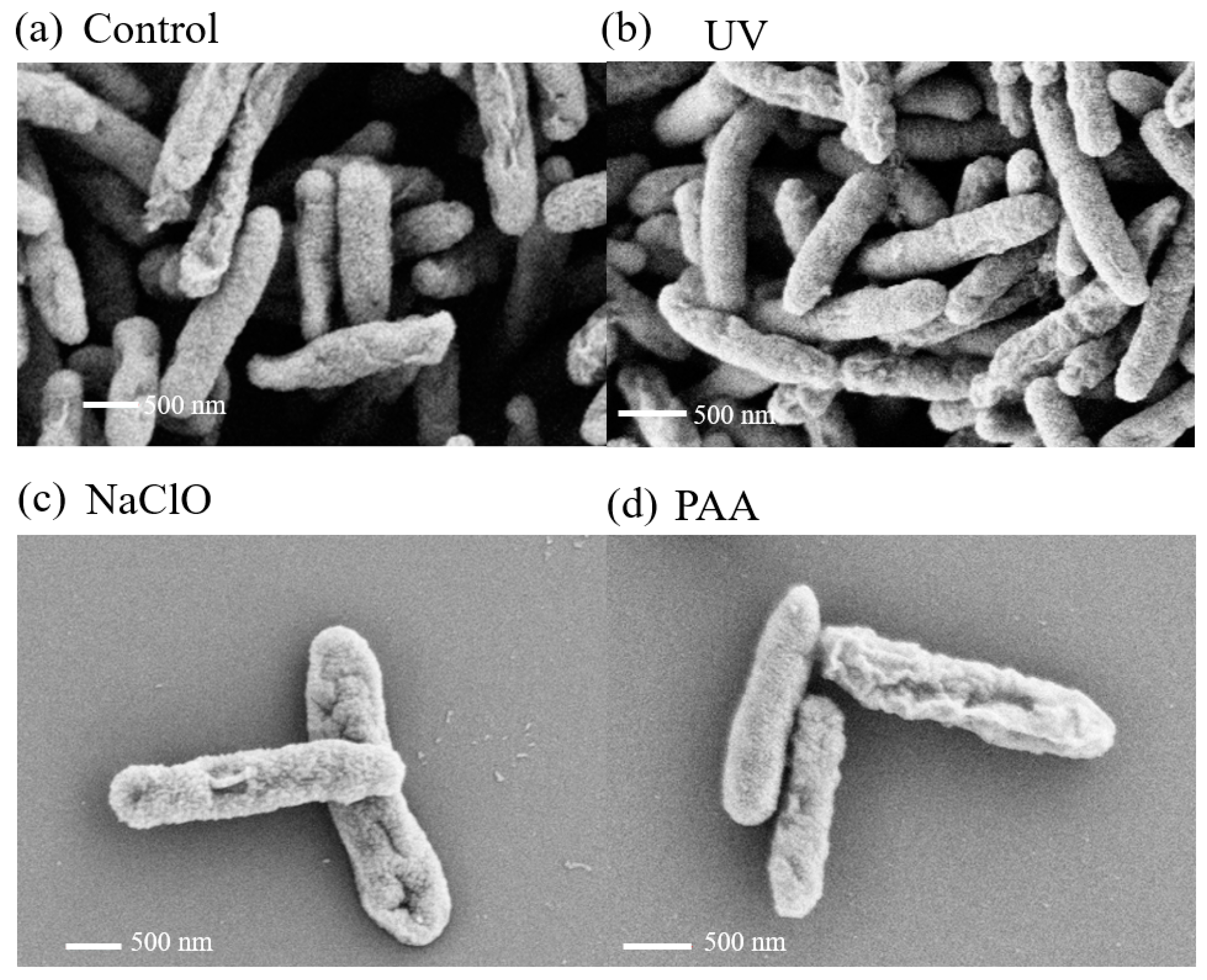Quantitative Detection of VBNC State Pseudomonas aeruginosa Contributing to Accurate Assessment of Microbial Inactivation in Drinking Water Disinfection
Abstract
1. Introduction
2. Materials and Methods
2.1. Cultivation and Preparation of P. aeruginosa Cells
2.2. Inactivation and Regrowth Experiments
2.3. PMA-qPCR and qPCR Standard Curve
2.4. Evaluation of PMA-qPCR Method Precision
2.5. Quantification of VBNC State P. aeruginosa
2.6. Assessment of Cell Membrane Morphology and Metabolic Activity
3. Results and Discussion
3.1. Integration of Modified qPCR and HPC for Accurate Quantification of VBNC P. aeruginosa
3.1.1. Validation of Long Primers for Accurate Detection of Viable P. aeruginosa in qPCR
3.1.2. Negligible Effect of PMA on qPCR Detection of Viable P. aeruginosa
3.1.3. PMA-qPCR for Selective Quantification of Viable P. aeruginosa in Viable–Dead Mixed Samples
3.2. Assessment of Various Disinfection Methods for Inducing a VBNC State in P. aeruginosa
3.2.1. Inactivation of Viable P. aeruginosa in UV Method
3.2.2. Inactivation of Viable P. aeruginosa in NaClO Method
3.2.3. Inactivation of Viable P. aeruginosa in PAA Method
3.2.4. Comparison of Inactivation Effects of Four Disinfection Methods
3.3. Resuscitation of VBNC P. aeruginosa
4. Conclusions
Supplementary Materials
Author Contributions
Funding
Data Availability Statement
Acknowledgments
Conflicts of Interest
References
- Moreira, N.F.F.; Ribeirinho-Soares, S.; Viana, A.T.; Graça, C.A.L.; Ribeiro, A.R.L.; Castelhano, N.; Egas, C.; Pereira, M.F.R.; Silva, A.M.T.; Nunes, O.C. Rethinking water treatment targets: Bacteria regrowth under unprovable conditions. Water Res. 2021, 201, 117374. [Google Scholar] [CrossRef] [PubMed]
- Wang, H.; Edwards, M.A.; Falkinham, J.O.I.; Pruden, A. Probiotic Approach to Pathogen Control in Premise Plumbing Systems? A Review. Environ. Sci. Technol. 2013, 47, 10117–10128. [Google Scholar] [CrossRef] [PubMed]
- Chen, S.; Li, X.; Wang, Y.; Zeng, J.; Ye, C.; Li, X.; Guo, L.; Zhang, S.; Yu, X. Induction of Escherichia coli into a VBNC state through chlorination/chloramination and differences in characteristics of the bacterium between states. Water Res. 2018, 142, 279–288. [Google Scholar] [CrossRef] [PubMed]
- Zhang, S.; Ye, C.; Lin, H.; Lv, L.; Yu, X. UV Disinfection Induces a Vbnc State in Escherichia coli and Pseudomonas aeruginosa. Environ. Sci. Technol. 2015, 49, 1721–1728. [Google Scholar] [CrossRef] [PubMed]
- Yin, W.; Yang, L.; Zhou, X.; Liu, T.; Zhang, L.; Xu, Y.; Li, N.; Chen, J.; Zhang, Y. Peracetic acid disinfection induces antibiotic-resistant E. coli into VBNC state but ineffectively eliminates the transmission potential of ARGs. Water Res. 2023, 242, 120260. [Google Scholar] [CrossRef] [PubMed]
- Dietersdorfer, E.; Kirschner, A.; Schrammel, B.; Ohradanova-Repic, A.; Stockinger, H.; Sommer, R.; Walochnik, J.; Cervero-Aragó, S. Starved viable but non-culturable (VBNC) Legionella strains can infect and replicate in amoebae and human macrophages. Water Res. 2018, 141, 428–438. [Google Scholar] [CrossRef] [PubMed]
- Oliver, J.D. The Public Health Significance of Viable but Nonculturable Bacteria. In Nonculturable Microorganisms in the Environment; Colwell, R.R., Grimes, D.J., Eds.; Springer: Boston, MA, USA, 2000; pp. 277–300. ISBN 978-1-4757-0273-6. [Google Scholar]
- Guo, L.; Ye, C.; Cui, L.; Wan, K.; Chen, S.; Zhang, S.; Yu, X. Population and single cell metabolic activity of UV-induced VBNC bacteria determined by CTC-FCM and D2O-labeled Raman spectroscopy. Environ. Int. 2019, 130, 104883. [Google Scholar] [CrossRef]
- Ma, X.; Wang, L.; Dai, L.; Kwok, L.-Y.; Bao, Q. Rapid Detection of the Activity of Lacticaseibacillus casei Zhang by Flow Cytometry. Foods 2023, 12, 1208. [Google Scholar] [CrossRef]
- Ogayar, E.; Larrañaga, I.; Lomba, A.; Kaberdin, V.R.; Arana, I.; Orruño, M. Efficiency and specificity of CARD-FISH probes in detection of marine vibrios. Environ. Microbiol. Rep. 2021, 13, 928–933. [Google Scholar] [CrossRef]
- Zhong, J.; Zhao, X. Detection of viable but non-culturable Escherichia coli O157:H7 by PCR in combination with propidium monoazide. 3 Biotech 2017, 8, 28. [Google Scholar] [CrossRef]
- Eischeid, A.C.; Linden, K.G. Molecular Indications of Protein Damage in Adenoviruses after UV Disinfection. Appl. Environ. Microbiol. 2011, 77, 1145–1147. [Google Scholar] [CrossRef] [PubMed]
- Eischeid, A.C.; Meyer, J.N.; Linden, K.G. UV Disinfection of Adenoviruses: Molecular Indications of DNA Damage Efficiency. Appl. Environ. Microbiol. 2009, 75, 23–28. [Google Scholar] [CrossRef] [PubMed]
- Zhou, X.; Ren, X.; Chen, Y.; Feng, H.; Yu, J.; Peng, K.; Zhang, Y.; Chen, W.; Tang, J.; Wang, J.; et al. Bacteria inactivation by sulfate radical: Progress and non-negligible disinfection by-products. Front. Environ. Sci. Eng. 2023, 17, 29. [Google Scholar] [CrossRef]
- Liao, X.; Liu, D.; Ding, T. Nonthermal Plasma Induces the Viable-but-Nonculturable State in Staphylococcus aureus via Metabolic Suppression and the Oxidative Stress Response. Appl. Environ. Microbiol. 2020, 86, e02216-19. [Google Scholar] [CrossRef] [PubMed]
- Yoon, J.-H.; Lee, S.-Y. Characteristics of viable-but-nonculturable Vibrio parahaemolyticus induced by nutrient-deficiency at cold temperature. Crit. Rev. Food Sci. Nutr. 2020, 60, 1302–1320. [Google Scholar] [CrossRef] [PubMed]
- Mizunoe, Y.; Wai, S.N.; Ishikawa, T.; Takade, A.; Yoshida, S. Resuscitation of viable but nonculturable cells of Vibrio parahaemolyticus induced at low temperature under starvation. FEMS Microbiol. Lett. 2000, 186, 115–120. [Google Scholar] [CrossRef] [PubMed]
- Wang, L.; Ye, C.; Guo, L.; Chen, C.; Kong, X.; Chen, Y.; Shu, L.; Wang, P.; Yu, X.; Fang, J. Assessment of the UV/Chlorine Process in the Disinfection of Pseudomonas aeruginosa: Efficiency and Mechanism. Environ. Sci. Technol. 2021, 55, 9221–9230. [Google Scholar] [CrossRef]
- Hu, Z.; Bai, X. Self-repair and resuscitation of viable injured bacteria in chlorinated drinking water: Achromobacter as an example. Water Res. 2023, 245, 120585. [Google Scholar] [CrossRef]
- Rui, J.; Zhang, L.; Zhao, Y.; Huang, X. Potential Risks of Pseudomonas aeruginosa in Secondary Water Supply System. China Water Wastewater 2022, 38, 45–50. [Google Scholar]
- Rahn, R.O. Potassium Iodide as a Chemical Actinometer for 254 nm Radiation: Use of lodate as an Electron Scavenger. Photochem. Photobiol. 1997, 66, 450–455. [Google Scholar] [CrossRef]
- Ding, N.; Li, Z.; Jiang, L.; Liu, H.; Zhang, Y.; Sun, Y. Kinetics and mechanisms of bacteria disinfection by performic acid in wastewater: In comparison with peracetic acid and sodium hypochlorite. Sci. Total Environ. 2023, 878, 162606. [Google Scholar] [CrossRef] [PubMed]
- Sun, W.; Jing, Z.; Zhao, Z.; Yin, R.; Santoro, D.; Mao, T.; Lu, Z. Dose–Response Behavior of Pathogens and Surrogate Microorganisms across the Ultraviolet-C Spectrum: Inactivation Efficiencies, Action Spectra, and Mechanisms. Environ. Sci. Technol. 2023, 57, 10891–10900. [Google Scholar] [CrossRef] [PubMed]
- Xu, Y.-Q.; Wu, Y.-H.; Luo, L.-W.; Huang, B.-H.; Chen, Z.; Wang, H.-B.; Liu, H.; Ikuno, N.; Koji, N.; Hu, H.-Y. Inactivation of chlorine-resistant bacteria (CRB) via various disinfection methods: Resistance mechanism and relation with carbon source metabolism. Water Res. 2023, 244, 120531. [Google Scholar] [CrossRef] [PubMed]
- Cheng, S.; Su, R.; Song, L.; Bai, X.; Yang, H.; Li, Z.; Li, Z.; Zhan, X.; Xia, X.; Lü, X.; et al. Citral and trans-cinnamaldehyde, two plant-derived antimicrobial agents can induce Staphylococcus aureus into VBNC state with different characteristics. Food Microbiol. 2023, 112, 104241. [Google Scholar] [CrossRef] [PubMed]
- Pasquaroli, S.; Zandri, G.; Vignaroli, C.; Vuotto, C.; Donelli, G.; Biavasco, F. Antibiotic pressure can induce the viable but non-culturable state in Staphylococcus aureus growing in biofilms. J. Antimicrob. Chemother. 2013, 68, 1812–1817. [Google Scholar] [CrossRef] [PubMed]
- Zhang, Y.; Liu, J.; Cao, M.; Zhang, Y.; Zhang, X. Role of Resuscitation Promoting Factor-like Protein from Nocardiopsis halophila. Microorganisms 2023, 11, 485. [Google Scholar] [CrossRef]
- Chaffey, N.; Alberts, B.; Johnson, A.; Lewis, J.; Raff, M.; Roberts, K.; Walter, P. Molecular biology of the cell. 4th edn. Ann. Bot. 2003, 91, 401. [Google Scholar] [CrossRef]
- Zimmermann, H. 5′-Nucleotidase: Molecular structure and functional aspects. Biochem. J. 1992, 285, 345–365. [Google Scholar] [CrossRef]
- Venkateswaran, K.; Hattori, N.; La Duc, M.T.; Kern, R. ATP as a biomarker of viable microorganisms in clean-room facilities. J. Microbiol. Methods 2003, 52, 367–377. [Google Scholar] [CrossRef]
- Guo, L.; Ye, C.; Yu, X.; Horn, H. Induction of bacteria in biofilm into a VBNC state by chlorine and monitoring of biofilm structure changes by means of OCT. Sci. Total Environ. 2023, 891, 164294. [Google Scholar] [CrossRef]
- Venkobachar, C.; Iyengar, L.; Prabhakara Rao, A.V.S. Mechanism of disinfection: Effect of chlorine on cell membrane functions. Water Res. 1977, 11, 727–729. [Google Scholar] [CrossRef]
- Lindmark, M.; Cherukumilli, K.; Crider, Y.S.; Marcenac, P.; Lozier, M.; Voth-Gaeddert, L.; Lantagne, D.S.; Mihelcic, J.R.; Zhang, Q.M.; Just, C.; et al. Passive In-Line Chlorination for Drinking Water Disinfection: A Critical Review. Environ. Sci. Technol. 2022, 56, 9164–9181. [Google Scholar] [CrossRef] [PubMed]
- Lee, S.H.I.; Cappato, L.P.; Corassin, C.H.; Cruz, A.G.; Oliveira, C.A.F. Effect of peracetic acid on biofilms formed by Staphylococcus aureus and Listeria monocytogenes isolated from dairy plants. J. Dairy Sci. 2016, 99, 2384–2390. [Google Scholar] [CrossRef] [PubMed]
- Zhang, C.; Brown, P.J.B.; Hu, Z. Higher functionality of bacterial plasmid DNA in water after peracetic acid disinfection compared with chlorination. Sci. Total Environ. 2019, 685, 419–427. [Google Scholar] [CrossRef]







| Primer Name | Primer Sequence (5′ → 3′) | Amplification Product Size |
|---|---|---|
| opr-SF | GACGTACACGCGAAAGACCT | 99 bp |
| opr-SR | GCCCAGAGCCATGTTGTACT | |
| opr-LF | ATGGAAATGCTGAAATTCGGC | 504 bp |
| opr-LR | CTTCTTCAGCTCGACGCGACG |
Disclaimer/Publisher’s Note: The statements, opinions and data contained in all publications are solely those of the individual author(s) and contributor(s) and not of MDPI and/or the editor(s). MDPI and/or the editor(s) disclaim responsibility for any injury to people or property resulting from any ideas, methods, instructions or products referred to in the content. |
© 2024 by the authors. Licensee MDPI, Basel, Switzerland. This article is an open access article distributed under the terms and conditions of the Creative Commons Attribution (CC BY) license (https://creativecommons.org/licenses/by/4.0/).
Share and Cite
Fan, Z.; Zhu, H.; Tao, C.; Deng, N.; Huang, X. Quantitative Detection of VBNC State Pseudomonas aeruginosa Contributing to Accurate Assessment of Microbial Inactivation in Drinking Water Disinfection. Water 2024, 16, 236. https://doi.org/10.3390/w16020236
Fan Z, Zhu H, Tao C, Deng N, Huang X. Quantitative Detection of VBNC State Pseudomonas aeruginosa Contributing to Accurate Assessment of Microbial Inactivation in Drinking Water Disinfection. Water. 2024; 16(2):236. https://doi.org/10.3390/w16020236
Chicago/Turabian StyleFan, Zhiheng, Huichao Zhu, Chen Tao, Ning Deng, and Xin Huang. 2024. "Quantitative Detection of VBNC State Pseudomonas aeruginosa Contributing to Accurate Assessment of Microbial Inactivation in Drinking Water Disinfection" Water 16, no. 2: 236. https://doi.org/10.3390/w16020236
APA StyleFan, Z., Zhu, H., Tao, C., Deng, N., & Huang, X. (2024). Quantitative Detection of VBNC State Pseudomonas aeruginosa Contributing to Accurate Assessment of Microbial Inactivation in Drinking Water Disinfection. Water, 16(2), 236. https://doi.org/10.3390/w16020236







